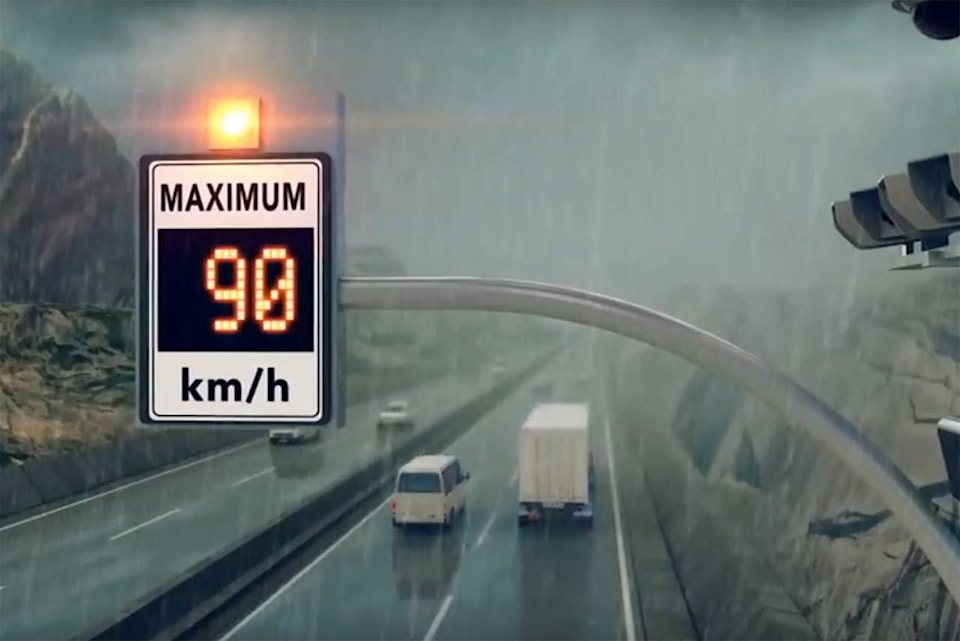The installation of variable speed limit systems may be a little like putting a Band-Aid on a broken leg, but it’s better than nothing.
Mayor Sharon Gaetz said she’s grateful for the provincial government’s announcement to spend $25 million on the congestion-based speed limit systems from Abbotsford to Chilliwack, but the bigger issue is highway widening.
“[The provincial government] knows the highway needs to be widened,” Gaetz said Wednesday. “It’s a question of money and funding and how they could do that.”
• READ MORE: Highway One widening in Langley to Abbotsford may not happen now
The Ministry of Transportation and Infrastructure announced installation would begin this week on two variable speed limit systems on the 24-kilometre stretch of Highway 1 between Sumas River Bridge in Abbotsford and the Prest Road overpass in Chilliwack.
(See below for video of what the signs look like.)
The idea behind the systems is to lower the speed limit to slow vehicles down before traffic reaches a stop-and-go situation, helping to reduce the number of collisions that occur when drivers do not notice vehicles that have stopped on the highway.
“People are frustrated with being stuck in bumper-to-bumper traffic on this busy stretch of Highway 1, and crashes during congestion means it takes even longer to get moving again,” said Claire Trevena, Minister of Transportation and Infrastructure. “We are installing new technology – a first for B.C. – to adjust speeds before a traffic jam develops, which should reduce accidents, as well as traffic delays.”
And while traffic counts have increased steadily if slowly in recent years, accidents have increased significantly.
The Ministry’s numbers show traffic on the Highway 1 corridor went from an average of 45,500 vehicles per day in 2013, to 53,000 counted in 2017, just west of Vedder Road in Chilliwack.
That’s an increase of 16.5 per cent in four years. In that same period, accidents have gone from 720 to 1,100 per year, an increase of 52 per cent, according to ICBC data provided to city hall.
“I’m very grateful for the variable speed signal and I’m hopeful that will stop those accidents, in particular the casualties,” Gaetz said. “There has been an exponential rise in accidents on the freeway.”
The Ministry of Transportation says the number of “severe collisions” between Abbotsford and Chilliwack over the last five years was approximately 86 per year, and other jurisdictions report approximately 10 per cent reductions of serious collisions in variable speed limit zones.
On Highway 3, between Hope and the Highway 3/5 junction, a road and weather-based variable speed limit system will also be installed along this seven-kilometre stretch. Here, the system will collect data, from road surface sensors and traffic sensors, to lower speeds in bad weather.
The ministry expects all these systems to be operational in summer 2019.
The total cost of implementing new variable speed limit systems on Highways 1 and 3 is estimated at $25 million, which includes the system components, such as electronic signs, electrical cabinets, and traffic and weather sensors. The ministry has awarded an $11.35-million contract to MRC Total Build LP of Langley.
Gaetz did not say the money shouldn’t be spent, but she emphasized how much more important it is for Chilliwack to get a third lane in each direction, particularly as real estate costs prompt more and more people to move from Metro Vancouver to the Eastern Fraser Valley.
“You need a third lane in there and then we could discuss if that would be used for regular traffic or a truck lane like in Washington.
“I think the message that I have been trying to get out is that we live here and we see what is happening on our freeway. At peak times, during rush hour, we see it bumper to bumper, cars going 20 to 40 kilometres an hour for long stretches. At this point, there really is no alternatives for people. We don’t have a lot of busing, the Fraser Valley Express runs at various times of day, but for a lot of people it’s not convenient.”
• READ MORE: Expanded service this fall (2017) coming for the FVX and Chilliwack transit
@PeeJayAitch
paul.henderson@theprogress.com
Like us on Facebook and follow us on Twitter.
